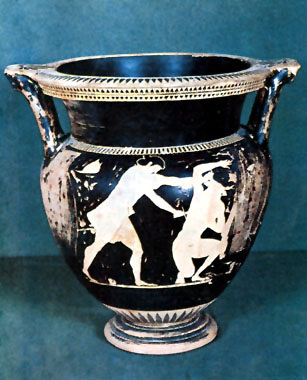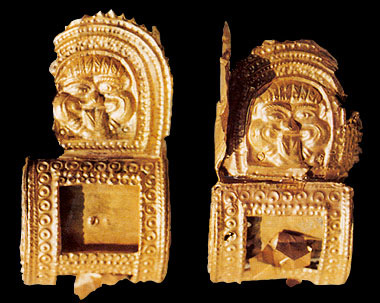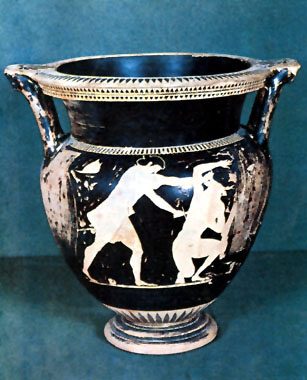Tomb of Rio Ralletta

Information
Recommended season:
All the seasons
Contacts:
National musuem of Villa Guinigi
Era:
V century b.C.
District/Location:
Capannori
District:
Piana di Lucca


From the moment it was found, in 1892, during draining works in the Bientina basin, the Rio Ralletta tomb has been one of the bases on which the long discussed Etruscan settlement of the Auser plain was defined. Distinguished by a precious cinerary urn and by a rich set of jewellery, the tomb still represents a near to unique example in the panorama of findings related to Etruscan tombs in the territory of Lucca (Via Squaglia).
(text by SUSANNA BIANCHINI)
(text by SUSANNA BIANCHINI)
Tomba di Rio Ralletta Capannori
Remains not visible; cinerary urn and grave goods are on exposition at the National Museum of Villa Guinigi in Lucca.
According to information gathered at the moment of its discovery, the tomb consisted of a dolio of impasto covered with earth and a stone slab. An Attic crater with red figures, referable to the 'Pittore del Porco' (480-470 a.C.), served as cinerary vessel; the main scene on it shows Theseus killing the Minotaur. Inside the vase, together with the charred remains of the dead, certainly a woman, many personal ornaments were found. Two amber beads and a set of jewellery, made of gold leaf decorated in repoussé or pressed, including: a pair of earrings in form of a miniature case; a large pin with a pomegranate-shaped head; necklace pendants in form of harpy, small crown, fir-cone, acorn, lotus flower and berry; eleven small fibulae and six bird-shaped plaquettes, probably in origin appliques for fabrics. This set of objects confirms the dating of the cinerary urn to the first decades of the Vth century B.C..
Although the burial still follow Iron Age practices, simply replacing the plain olla with a more precious vessel, the wealth of grave goods proves the considerable economic prosperity reached, in this period, by the Etruscans settled in the plain of Lucca (Chiarone, Fossa Nera, Tempagnano, Romito di Pozzuolo). The demographic expansion, already under way at the end of the VIIth century B.C., reached indeed its climax exactly in the first half of the Vth century B.C.
bibliography:
- Mencacci P., Zecchini M., Lucca preistorica, Lucca 1976
- Cristofani M., L'oro degli etruschi, Novara 1985
- Ciampoltrini G., Aspetti dell'insediamento etrusco nella valle del Serchio: il V sec. a.C., in "Studi Etruschi" LIX, 1994
- Ciampoltrini G. (a cura di), gli Etruschi del Bientina. Storie di comunità rurali fra X e V secolo a.C., Buti 1999
Although the burial still follow Iron Age practices, simply replacing the plain olla with a more precious vessel, the wealth of grave goods proves the considerable economic prosperity reached, in this period, by the Etruscans settled in the plain of Lucca (Chiarone, Fossa Nera, Tempagnano, Romito di Pozzuolo). The demographic expansion, already under way at the end of the VIIth century B.C., reached indeed its climax exactly in the first half of the Vth century B.C.
bibliography:
- Mencacci P., Zecchini M., Lucca preistorica, Lucca 1976
- Cristofani M., L'oro degli etruschi, Novara 1985
- Ciampoltrini G., Aspetti dell'insediamento etrusco nella valle del Serchio: il V sec. a.C., in "Studi Etruschi" LIX, 1994
- Ciampoltrini G. (a cura di), gli Etruschi del Bientina. Storie di comunità rurali fra X e V secolo a.C., Buti 1999
- MENCACCI P., ZECCHINI M., Lucca preistorica, Lucca 1976
- CRISTOFANI M., L'oro degli etruschi, Novara 1985
- CIAMPOLTRINI G., Aspetti dell'insediamento etrusco nella valle del Serchio: il V sec. a.C., in "Studi Etruschi" LIX, 1994
- CIAMPOLTRINI G. (a cura di), Gli Etruschi del Bientina. Storie di comunità rurali fra X e V secolo a.C., Buti 1999
Scopri altre attrazioni vicino a Tomb of Rio Ralletta
See allYou may also like..
See all
0















